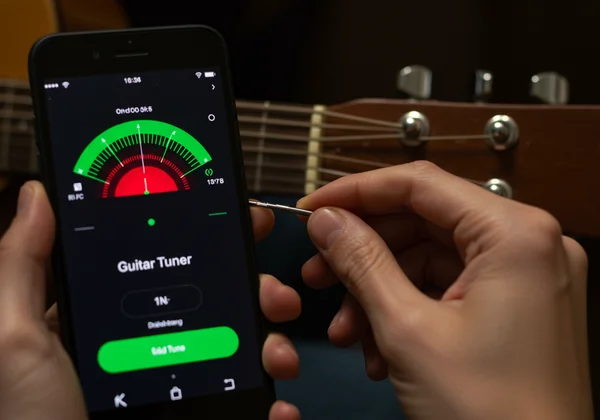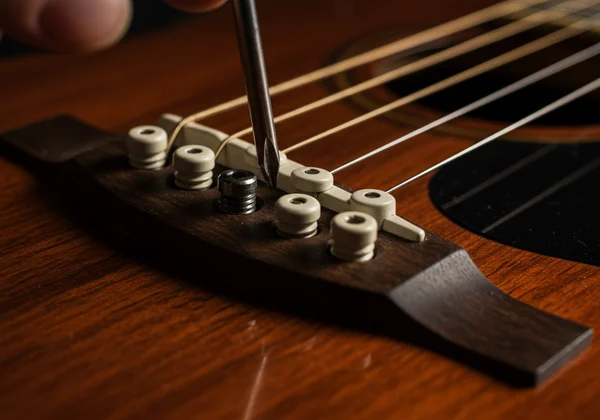Master Guitar Tuning Online: Your Ultimate Guide to Standard & Alternate Tunings
Learning to tune your guitar is the very first and most important step for any guitarist, whether you're just starting in your bedroom or playing gigs on stage. A guitar that's out of tune can make even the best players sound a bit off, but a perfectly tuned instrument lays down a clear, rich foundation for beautiful music. With so many choices out there, you might be wondering, how do you tune a guitar online? Good news—it's simpler and more accessible than you might think!
This guide will walk you through everything you need to know, from the fundamentals of standard tuning to the creative world of alternate tunings and advanced concepts like intonation. We’ll show you how to achieve perfect pitch every time using a simple, powerful tool. Get ready to master your sound with the best free online tuner available right in your browser.

Understanding Standard Guitar Tuning
Before you can shred like a rock star or strum a gentle folk song, you need to understand the universal language of guitar tuning: Standard Tuning. This is the bedrock upon which nearly all guitar music and learning resources are built.
What is E Standard Tuning (EADGBE)?
E Standard Tuning is the most common configuration for a six-string guitar. The open strings are tuned from thickest (lowest pitch) to thinnest (highest pitch) as follows:
- 6th String (thickest): E₂
- 5th String: A₂
- 4th String: D₃
- 3rd String: G₃
- 2nd String: B₃
- **1st String (thinnest): E₄
A helpful mnemonic to remember this is "Eddie Ate Dynamite, Good Bye Eddie." When your guitar is set to EADGBE, all the chord shapes and scale patterns you learn will sound correct.
Why Accurate Standard Tuning is Essential for Every Musician
Think of standard tuning as your musical GPS. It's essential because:
- For Learning: Every beginner tutorial, chord chart, and tab assumes standard tuning.
- For Jamming: Playing with others or along with recordings requires you to be in tune.
- For Your Ear: Regular tuning sharpens your pitch recognition, a key skill for any musician.
Skip accurate tuning, and your music will sound off, making progress frustrating.
How to Tune Your Guitar with an Online Tuner
Forget about needing a bulky physical tuner. Now, with a quality online guitar tuner, all you need is your instrument and a device with a microphone. It’s simply the fastest and most convenient way to make sure your guitar is always ready to sing.
Step-by-Step Guide to Using Tuner.wiki's Online Guitar Tuner
Using an online tuner is incredibly straightforward. Here’s how you can get perfect pitch in under a minute with our accurate online tuner:
-
Visit the Website: Open your browser on your computer, tablet, or phone and navigate to our free online tuner.
-
Allow Microphone Access: When prompted, grant permission for the site to use your microphone. The tuner needs this to hear your guitar.
-
Select Your Instrument (Optional): For a guided experience, select "Guitar" and "Standard Tuning" from the presets.
-
Pluck a String: Pluck the thickest string (low E) and let it ring out.
-
Read the Feedback: The tuner shows if the note is sharp (too high), flat (too low), or in tune.
-
Adjust the Tuning Peg: Tighten the peg if the note is flat (too low) or loosen it if it's sharp (too high). Keep adjusting until the indicator turns green. Repeat for all six strings (E-A-D-G-B-E).

Tips for Accurate Microphone Tuning & Overcoming Challenges
To get the best results from a microphone tuner, follow these simple tips:
- Tune in a quiet room: Background noise can interfere with the microphone.
- Mute other strings: Use your hand to ensure the tuner only hears one string at a time.
- Pluck consistently: A firm, even pluck works best. Plucking too hard can make the note temporarily sharp.
- Get close: Position your device's microphone near your guitar's soundhole for a clear signal.
Exploring Alternate Guitar Tunings
Once you've mastered standard tuning, a whole new world of sound awaits with alternate guitar tunings. By changing the pitch of one or more strings, you can create unique moods and unlock new creative possibilities. Our online instrument tuner is a chromatic tuner, meaning it can help you find any note, making it perfect for experimenting.

Unleashing Creativity with Drop D Tuning
A great first step into alternate tunings, Drop D is simple: just tune your low E string down to D (D-A-D-G-B-E). This gives you a heavier, deeper sound perfect for rock and metal, and makes playing power chords on the low strings a breeze.
The Rhythmic Power of Open G Tuning
Popular with slide and blues players, Open G tuning (D-G-D-G-B-D) creates a G major chord with just an open strum. It has a fantastic ringing quality, ideal for rhythmic strumming and slide guitar.
When and Why to Experiment with Different Tunings
Alternate tunings are perfect for breaking a creative rut. They force you to rediscover the fretboard and find new sounds. Experiment to match a song's key, create a unique texture, or simplify complex chords.
Beyond Basic Tuning: Mastering Guitar Intonation
Have you ever tuned your guitar perfectly, only to find that chords played higher up the neck sound horribly out of tune? The problem might not be your tuning—it could be your guitar intonation.
What is Intonation and Why It Matters for Perfect Pitch
Intonation is your guitar's ability to stay in tune all across the fretboard. If it's off, your open strings might be perfect, but chords played higher up the neck will sound sour. Good intonation is key for perfect pitch everywhere.
Signs of Poor Guitar Intonation and How to Identify Them
The main sign of bad intonation is when open chords sound fine but barre chords up the neck sound off. To check it with an accurate tuner:
-
Tune an open string perfectly.
-
Play the note at the 12th fret.
-
It should be the exact same note, one octave higher. If the tuner shows it's sharp or flat, your intonation needs adjusting.

Basic Checks: When to Adjust and When to Seek a Luthier
Adjusting intonation involves moving the small saddles at the bridge. If you're not comfortable with mechanical adjustments or the problem is significant, it's best to see a professional luthier for a proper setup.
Guitar Maintenance for Better Tuning Stability
A well-maintained guitar is a guitar that stays in tune longer. Simple care habits can make a huge difference in your instrument’s tuning stability.
The Crucial Role of Fresh Guitar Strings in Staying in Tune
Fresh guitar strings are key for tuning stability. Old strings collect grime, lose elasticity, and won't hold their pitch, sounding dull and going out of tune easily. Change them regularly—every 1-3 months for casual players, and more often if you play a lot.
Quick Tips for Everyday Guitar Care and Longevity
- Wipe down strings: Use a dry cloth after playing to remove corrosive sweat and oils.
- Store properly: Keep your guitar in a case to protect it from temperature and humidity changes that warp the wood.
- Stretch new strings: When restringing, tune up, then gently pull each string away from the fretboard. Retune and repeat until the pitch holds steady.
Your Journey to Perfectly Tuned Guitar Begins Here
Now you have the knowledge to master your guitar's sound, from EADGBE basics to creative alternate tunings. Remember, tuning isn't a one-time task; it's the foundation of great tone and confident playing. The best tool is accurate, reliable, and always ready.
With our online tuner, you have a professional-grade tool at your fingertips—no downloads, no interruptions. Ready to play in perfect harmony? Start tuning now and hear the difference.
Frequently Asked Questions About Guitar Tuning
Is an online guitar tuner as accurate as a physical one?
Yes! Modern online tuners, like ours, use sophisticated algorithms that rival the precision of many physical tuners. Their key advantage is convenience, working instantly on any device.
How often should I tune my guitar?
You should check your tuning every time you play. Changes in temperature, humidity, and even your playing style can knock it out of tune. Making it a quick pre-session habit ensures you always sound great.
Can I use our online tuner to tune my guitar with just my phone?
Absolutely. Our tool is browser-based, so it works on any smartphone with a web browser and a microphone. Just visit the site, allow microphone access, and you have a powerful guitar tuner in your pocket.
What does "chromatic tuner" mean for guitarists?
A chromatic tuner detects all 12 musical pitches. Unlike basic tuners that only recognize the six standard guitar notes, a chromatic tuner is more versatile, letting you explore any alternate tuning.
My guitar sounds off even when tuned. What could be wrong?
If your open strings are in tune but chords sound off, the likely culprit is poor intonation (see above). It could also be old strings that won't hold pitch or an issue with the guitar's nut or bridge. Start by checking your intonation with an online tuner.